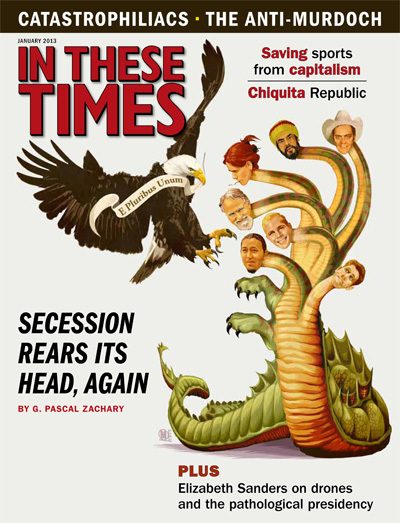
An overwhelming majority of Californians voted for Proposition 35, the “Californians Against Sexual Exploitation Act,” this November, swayed by gripping campaign imagery: a teenage girl tricked and kidnapped by a powerful pimp, then forced to provide sexual services to multiple men. Yet many anti-trafficking groups say that this paradigm is dangerously simplistic — and that Prop. 35 is a flawed measure that could harm those it intends to help.
Help keep this reporting possible by making a donation today.
Prop. 35 is the latest in a slew of controversial state-level anti-trafficking laws that boost police resources and increase criminal penalties. To discuss the ramifications of these laws, In These Times convened four experts: Kelli Dorsey, executive director of Different Avenues, which advocates for girls and women engaged in alternative economies such as prostitution; Ken Franzblau, an anti-trafficking consultant for Equality Now; Emi Koyama, an activist focusing on violence in and out of the sex trade; and Stephanie Richard from the California-based Coalition to Abolish Slavery and Trafficking.
In These Times: The ACLU and Electronic Frontier Foundation have challenged Prop. 35, alleging that it violates online freedom of speech, so the law is tied up in court. But if it does go into effect, what might its impact be?
Stephanie: Overall, Prop. 35 has really increased public awareness of human trafficking in California. But many experts in the field are also concerned about how it will ultimately impact survivors.
Kelli: This was obviously a well-intended measure. But in designing Prop. 35, the people behind it — a community activist new to the issue and a millionaire funder — didn’t consult with victims of trafficking, or the groups who work with them.
The measure’s description of trafficking is extremely broad. People under the age of 18 participating in the sex trade could potentially be charged as traffickers for aiding each other — sharing resources, sharing clients — even though harm-reduction service providers suggest [to sex workers] that they partner up to be safer. Prop. 35 overlaps with good laws already in place to help people who have been trafficked
In the past year, nearly 30 states have passed human trafficking legislation. Why this push for new laws?
Emi: We’re in the midst of a “war on trafficking.” It’s similar to the “war on drugs” and the “war on terror” in that we’ve removed these acts — drug use, terrorism, trafficking — from the contexts in which they occur. When we talk about trafficking, we need to think about both “push” and “pull” factors — meaning, social factors like poverty and racism that push people to become vulnerable to begin with, as well as abusive or exploitative arrangements they may be pulled into because resources are inadequate. Instead, we ignore all that and focus on the “bad people” — usually portrayed in the media as urban men of color kidnapping young, white girls. We assume that if we put them in prison, everything will be solved.
Ken: But the benefit of legislation like Prop. 35 is that it does focus on the bad people: the traffickers. In most jurisdictions, currently, the people engaging in prostitution are the ones treated as criminals. The approach we need to embrace is decriminalization of people in prostitution, in conjunction with increased penalties for those who purchase sex. This is the model already used across Scandinavia.
You’re talking about a strategy to curb prostitution by ending demand for it. Is this also a strategy to combat human trafficking?
Kelli: Sex trafficking and the sex trade are routinely conflated, including by promoting “ending demand” for prostitution as an anti-trafficking strategy. But the majority of people in the sex trade are not trafficked. Going after buyers of commercial sex ends up driving sex work further underground, increasing the risk of violence.
Ken: I have to disagree with that. By criminalizing only the purchase of commercial sex, you’re no longer prosecuting victims. Trafficking in Sweden, as well as the number of women in prostitution, has dropped dramatically since the inception of this approach. By contrast, everywhere we see full legalization of prostitution, we see increases in trafficking.
Kelli: But you can’t just direct resources to law enforcement and not have it also impact the people in the sex trade. When we fail to employ a race and class analysis of policing, we miss how these laws play out in communities of color.
This issue is partly a terminological one: How is trafficking defined, and what phenomena might not be captured in this definition?
Stephanie: There is a federal definition of human trafficking that covers both labor and sex trafficking. But there is a lot of misunderstanding about this. So we end up with laws where there are lower penalties for labor trafficking, which sends the message that one crime is worse than another. When people are looking at initiatives around trafficking, they should ask whether they help all victims: men, women and children; U.S. citizens and foreign nationals; [victims of] labor and sex trafficking.
Emi: I appreciate the idea that we need to help all survivors of trafficking. But the concept of trafficking has become so broad that it’s no longer useful. It leads us to focus only on the most sensationalistic example: young people in the sex trade.
When the first comprehensive federal anti-trafficking legislation was passed in 2000, all youth under 18 involved in the sex trade were reclassified as trafficking victims. This marked the beginning of the focus on youth trading sex — but it hasn’t prevented them from being arrested for prostitution. Why?
Stephanie: The fact of the matter is that if you are a minor or under the age of 18 in California, [even under Prop. 35] you can still be arrested for prostitution and criminally charged: That’s happening to kids as young as 11 and 12. We have this odd conflict in our law where it’s statutory rape for an adult to engage in sex with a minor, yet a minor can be prosecuted for commercial sex.
Ken: We need laws that say we won’t arrest minors for prostitution-related offenses. In New York, we’ve had such a policy in place for five years now, but [police still] arrest anybody in prostitution. It’s going to take a lot of training and education of law enforcement to change this.
Emi: Harassment against people in the sex trade is connected to police conduct toward people of color, queer and transient people and street youth, who suffer pervasive violence, surveillance and harassment. How can we expect to change that simply by educating the police? There’s an assumption that “decriminalization” means that people in the sex trade won’t be punished. But they’re already criminalized.
How, then, might we better protect the human rights of sex workers and trafficking victims?
Emi: The mainstream sex workers’ movement has long emphasized decriminalization. The assumption — which is a fairly white, middle class one — is that people who are in the sex trade are targeted because prostitution is illegal. No: People in the sex trade are targeted already, and the laws about prostitution simply make it easier.
Kelli: I’ll give you an example of this. D.C. has “prostitution-free zones” based on anti-loitering laws. If two or more people are standing on the street for a certain period of time without an apparent destination, they can be arrested. But if prostitution were legal, black folks, immigrants and LGBT folks still couldn’t stand on the corner without being harassed by police.
Emi: We need a movement for anti-criminalization that challenges the overreach of policing, which the mainstream anti-trafficking movement has advanced.
Ken: We also shouldn’t make the perfect the enemy of the good. I think the reason why Prop. 35 got such broad support is that it takes steps in the right direction.
Rebecca Burns is an In These Times contributing editor and award-winning investigative reporter. Her work has appeared in Bloomberg, the Chicago Reader, ProPublica, The Intercept, and USA Today. Follow her on Twitter @rejburns.









